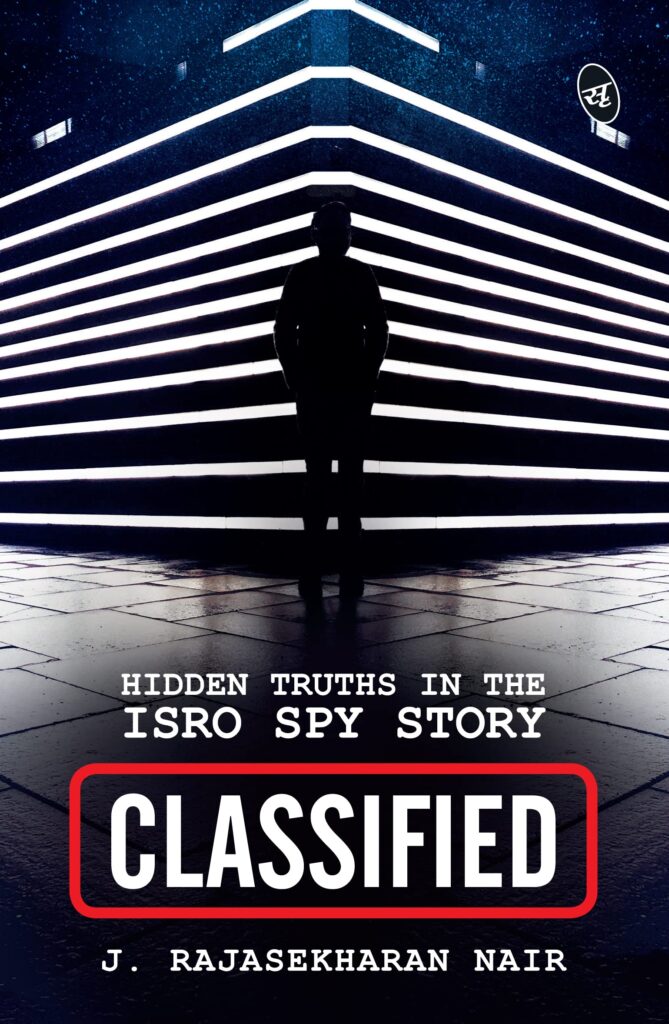
From – Prologue (CLASSIFIED By J. Rajshekharan Nair)
Twenty-seven years after it hit the headlines, the Indian Space Research Organisation (ISRO) espionage case is still alive and kicking. This time, with Central Bureau of Investigation (CBI) registering the First Information Report (FIR) before the Chief Judicial Magistrate (CJM), Thiruvananthapuram, against seven Kerala Police officers and eleven officers from IB, all retired, for conspiring to effectuate the illegal arrest and subsequent torture of S. Nambi Narayanan, one of the six discharged ‘accused’ in the spy case (1994).
The new development has pushed the public into a mire of contrived truths. That’s partly because of the asinine and disgusting move to project the espionage case as the sad story of S. Nambi Narayanan, effacing even the names of the other five victims – two of whom are no more – from public memory. It is also because of the stealthy manner in which the state agencies had reacted to the case then and now, and partly because of the hidden fractures in our system.
The latest FIR paints the old heroes as ‘villains’, and the media hail the old villains as ‘heroes’. It’s like scripting a comedy of errors, while the state agencies surreptitiously bury the wreckage of a failed reverse espionage – jointly planned by Glavkosmos, the Russian space organization, and the ISRO top brass and its technocrats, including S. Nambi Narayanan and D. Sasikumaran, to illegally transfer the cryogenic rocket technology from Glavkosmos to ISRO. It was done with the tacit support of the Russian government, hoodwinking the Central Intelligence Agency (CIA), after the ISRO-Glavkosmos agreement of 1991 to legally transfer the cryogenic rocket technology was scrapped by the Russian government in 1993, invoking force majeure, under severe pressure from the US administration.
Besides, furtive efforts are on to efface the remnants of the master plan of a clandestine operation, jointly conceived by Glavkosmos and ISRO. They had planned to use KELTEC (now, BrahMos Aerospace) at Thiruvananthapuram as a conduit to outwit the amended provisions of Missile Technology Control Regime (MTCR) and facilitate the transfer of cryogenic rocket technology
to ISRO in an illegal manner.
Meanwhile, the FIR has set the stage ready for yet another high-voltage drama with the courts in Kerala witnessing allegations and counter-allegations between the old villains and the new villains. And sadly, all that has nothing to do with the meat of the spy case.
If the ISRO spy case was false and baseless, as the CBI concluded after eighteen months of investigation, don’t we have the right to know who planted it?
If ISRO didn’t have cryogenic rocket technology in 1994 – when it was alleged to have been sold to Pakistan by two technocrats in ISRO with the help of two semi-literate Maldivian women – why didn’t the chairman of ISRO, the Space Commission or the Department of Space dismiss it as rubbish and nipped the absurd spy story in the bud on the first day itself? Why did they keep their mouths shut even when the nation’s pride and ISRO’s credibility were trampled upon and kicked on the street?
Interestingly, ISRO tweeted on 29 July 2021 that its chairman, Dr K. Sivan has formally launched its theme-based merchandise, including T-shirts, and claimed “customized ISRO-theme-based products can play a game-changing role in creating awareness and kindling the interest of the students, children and public in the domain of space science and technology, propagating the achievements and laurels that ISRO brings to the nation.”
I wonder what prevented the then Chairman Dr K. Kasturirangan from holding a press conference, in the first week of November 1994 itself, and telling the truth to the nation – that ISRO didn’t have the cryogenic rocket technology when it was alleged to have been leaked to Pakistan!
Had he done that – something you expect any officer of substance would do – he could have arrested the spread of lies churned out by the media and saved ISRO from the damage the espionage case caused it.
But then, why didn’t he do it? Did some agency bully him not to tell the truth? Did he really fear that he would be opening a can of worms if he dared to bust the absurd espionage story?
Why didn’t the editors, who sent reporters to the Maldives to collect information on the Maldivian women, send at least a cub reporter to VSSC, just eleven kilometers from the heart of Thiruvananthapuram, to enquire whether ISRO had cryogenic rocket technology in 1994?
As we delve into the spy case, more intriguing questions surface.
What was the legal authority of Kerala Police to register a case under the Indian Official Secrets Act (IOS), 1923, on a crime of spying in ISRO, a Central government organization?
complaint from ISRO or the Central government reaching the competent Magistrate?
How could Intelligence Bureau (IB), a ghost organization with no legal legitimacy to justify even its existence in the post-Independence India, interrogate and torture the accused persons while under police custody?
How could two learned judges of the Kerala High Court put on record that “IB which has its own investigation machinery ” in a crucial judgment in 1995, in a case connected to the ISRO spy case? How could the senior high court judges be that ignorant about the law of the land?
Why did the Supreme Court of India, through its judgment of 14 September 2018, make the espionage case appear to be the illegal arrest and torture of S. Nambi Narayanan, obliterating the transnational dimensions of a highly complex and equally complicated espionage case that had damning ramifications on the domestic front, exposing the truth of our premier institutions?
If it is proved beyond doubt that the custody of all the six accused was illegal – which is indeed what happened in the ISRO espionage case – doesn’t the state, of which the judiciary is an integral part, own a responsibility to order compensation for all wrongly accused?
Addressing the question, Justice Madan B. Lokur said, “How can people deal with this situation? The only answer is accountability, which has to be in two forms – One is financial accountability where a sufficient amount of compensation must be given. If S. Nambi Narayanan can be given fifty lakh rupees, surely a good amount of compensation can be given to all those people who have been wrongly arrested and detained. Once the courts start telling the police or the prosecution that you are bound to pay, I think they will probably come to their senses and not make unnecessary arrests. This is one aspect.”
S. Nambi Narayanan was in custody for 50 days. But it cannot be ignored that D. Sasikumaran, a former ISRO Engineer of equal stature, was under custody for 60 days; K. Chandrasekhar, agent of Glavkosmos, was under custody for 58 days; Sudhir Kumar Sharma, a labour contractor who didn’t even know the full form of ISRO when he was arrested, was under custody for 49 days; Fauziya Hassan, a Maldivian woman was under custody for 1000 days; and Marian Rasheeda, another Maldivian woman, was under custody for 1145 days. All the five were brutally tortured under illegal custody.
Then, why didn’t the Supreme Court think it was prudent to compensate all and not just S. Nambi Narayanan, one of the discharged ‘accused’, whose suit for damages (O.S. No.370/2003) to the tune of one crore rupees was pending before the sub-court in Thiruvananthapuram?
(Carried with due permission from author, publisher)
[the_ad id=”41101″]














